MyDigitalSSD SMART & BP3 mSATA SSD Review
by Kristian Vättö on January 22, 2013 1:24 PM ESTRandom Read/Write Speed
The four corners of SSD performance are as follows: random read, random write, sequential read and sequential write speed. Random accesses are generally small in size, while sequential accesses tend to be larger and thus we have the four Iometer tests we use in all of our reviews.
Our first test writes 4KB in a completely random pattern over an 8GB space of the drive to simulate the sort of random access that you'd see on an OS drive (even this is more stressful than a normal desktop user would see). I perform three concurrent IOs and run the test for 3 minutes. The results reported are in average MB/s over the entire time. We use both standard pseudo randomly generated data for each write as well as fully random data to show you both the maximum and minimum performance offered by SandForce based drives in these tests. The average performance of SF drives will likely be somewhere in between the two values for each drive you see in the graphs. For an understanding of why this matters, read our original SandForce article.
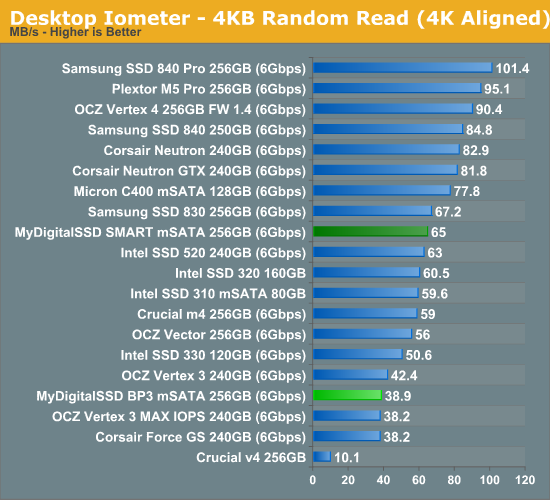
Compared to the PS3105 based Crucial v4, the BP3 offers a significant improvement in random read performance. It's still nowhere close to the fastest SATA 6Gbps drives, but at least the performance is no longer horrible. As for the SMART, its random read performance is similar to other SF-2281 based SSDs, as expected.
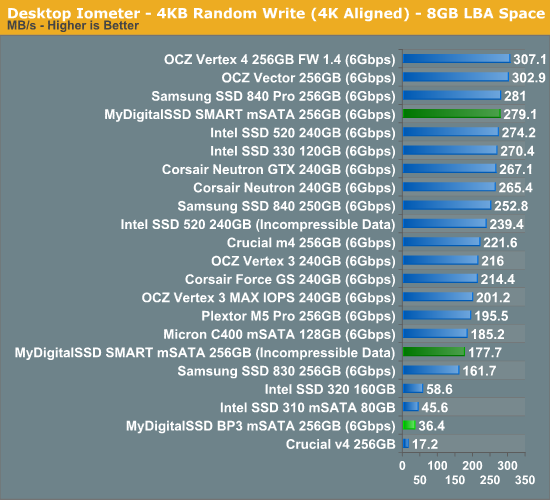
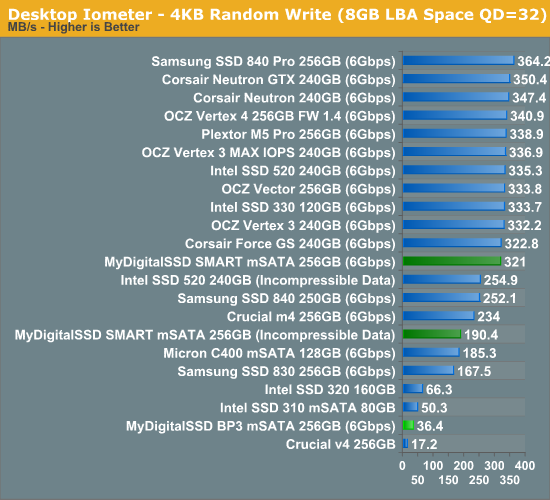
Random write speed is still the Achilles' Heel of Phison, though. The PS3108 is able to offer twice the performance of PS3105, but 36.4MB/s is still far slower than what most controllers are able to offer today. What's interesting is the fact that random write performance does not scale up at all when queue depth is increased—usually the throughput increases as the queue depth goes up as you can see in the graphs above.
Sequential Read/Write Speed
To measure sequential performance I ran a 1 minute long 128KB sequential test over the entire span of the drive at a queue depth of 1. The results reported are in average MB/s over the entire test length.
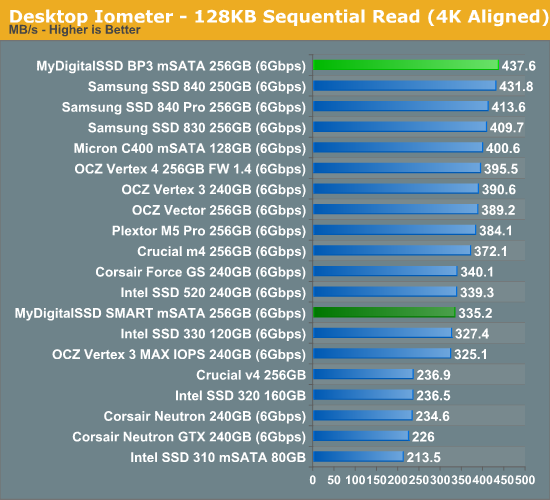
Similar to the Crucial v4, the BP3 has strong sequential performance. SMART's performance characteristics are once again typical SandForce, no surprises here.
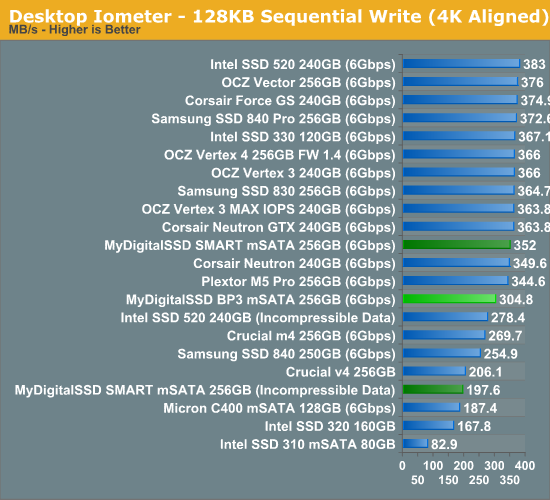
AS-SSD Incompressible Sequential Performance
The AS-SSD sequential benchmark uses incompressible data for all of its transfers. The result is a pretty big reduction in sequential write speed on SandForce based controllers, while other drives continue to work at roughly the same speed as with compressible data.
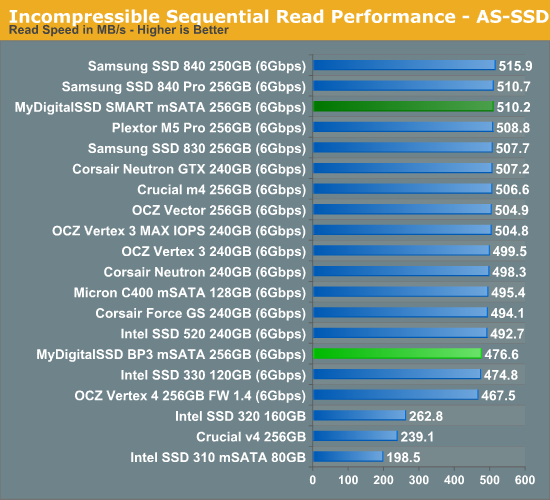
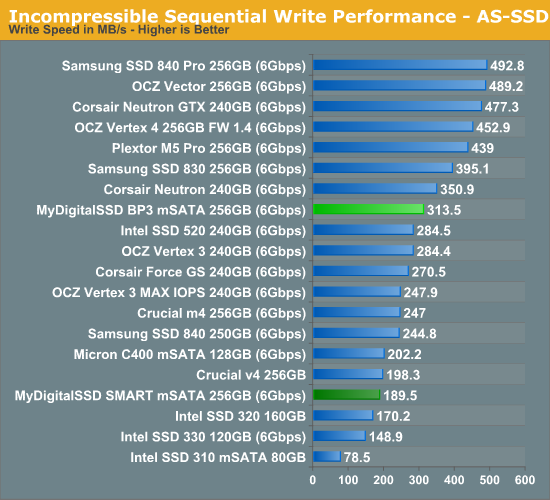










49 Comments
View All Comments
philipma1957 - Tuesday, January 22, 2013 - link
The crucial mSata 256gb is pretty good for asrock z77-itx board and for intels h77 itx board.They allow for a small desktop. I would like the 3 mobos I used to allow sata III they only allow Sata II.
philipma1957 - Tuesday, January 22, 2013 - link
Follow upI have these mobos
ASRock Z77E-ITX LGA 1155 Intel Z77 HDMI SATA 6Gb/s USB 3.0 Mini ITX Intel Motherboard
Intel BOXDH77DF LGA 1155 Intel H77 HDMI SATA 6Gb/s USB 3.0 Mini ITX Intel Motherboard
ASUS Maximus V Gene LGA 1155 Intel Z77 HDMI SATA 6Gb/s USB 3.0 Micro ATX Intel Motherboard
all are running with just the crucial msata 256gb ssds .
I would not mind one with a Sata III slot , I do agree msata is not offered as viable option for the system builder.
Death666Angel - Tuesday, January 22, 2013 - link
All I could find is that mSATA is only specified for SATA 1.5Gb/s and SATA 3 Gb/s, not SATA 6 Gb/s.nathanddrews - Tuesday, January 22, 2013 - link
Forgive me if I missed it, but should there be a benchmark showing performance consistency when factoring 25% spare area? Given AT's recent affinity for such benchmarks, I now expect to see it in every SSD review./rabble rabble!
Kristian Vättö - Tuesday, January 22, 2013 - link
It's not something we test with every drive because for example all SandForce drives behave the same way. I've actually had these drives for nearly six months and tested them long ago but the write up was pushed back by more urgent reviews. I know I may sound lazy here, but I don't consider the BP3 or SMART to be the choice for many already given the fact that mSATA isn't very popular and I see the majority of buyers going with name brands, so I decided not to test performance consistency this time.The random write speed is rather slow to begin with, and it gets below 1MB/s when tortured.
fugu_ - Tuesday, January 22, 2013 - link
It would have been nice to see performance consistency benchmarks for the drive that used the Phison controller, especially since there are only a handful of options for ~250GB mSATA drives.It's great to see any sort of reviews of lesser known drives. At the same time, it's a little disappointing that the perceived popularity of these drives stopped you from doing a more complete review, especially if you've had them for 6 months.
Kristian Vättö - Tuesday, January 22, 2013 - link
Yeah, I know it's not a proper excuse. This spring will be quite busy for me though, have plenty of SSDs to review and at the same time I should study for matriculation exams as well as university entrance exams.I know I shouldn't be making excuses, but I hope you can relate to my situation. I try to cut as few corners as possible but performance consistency is just PITA to test (well, the actual testing is fine but making the graphs is just painful because Microsoft can't make Office that's fully compatible with Office for Mac... Anand does the graphs on Mac, so I have to do too or they won't be identical). After that it's time for awful HTML editing which I suck at, so that takes way more time than it should.
Per Hansson - Wednesday, January 23, 2013 - link
Well if this is the place where we ask you to do performance consistency tests before your exams I'm in :)I would just love to see how the most crappy SSD controller of all; the JMicron JMF602 fares in performance consistency.
I think it would be a nice thing to look back at with what we know today.
Shockingly SSD's based on such controllers are still being sold!
http://www.prisjakt.nu/kategori.php?k=893#rparams=...
lyeoh - Wednesday, January 23, 2013 - link
Yeah I'd like to see the performance consistency for the lower end or even crap SSDs.Maybe even a few conventional spinning platter hard drives- low, mid, high.
Kristian Vättö - Wednesday, January 23, 2013 - link
Unfortunately, I don't have any SSDs that old. The "worst" SSDs I have are Crucial v4, OCZ Agility 4 and Samsung SSD 470. I could definitely run something on the V4 and BP3 to see if Phison has done any progress in this matter.